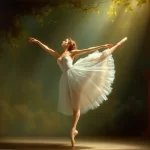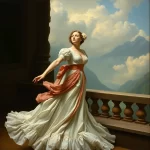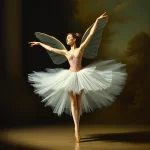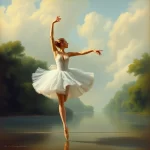Ballet: Giselle (Adolphe Adam, 1841)

Introduction
Ballet, a classical dance form known for its grace and precision, has produced many timeless works. One such masterpiece is “Giselle,” a romantic ballet composed by Adolphe Adam and choreographed by Jean Coralli and Jules Perrot. Premiering on June 28, 1841, at the Salle Le Peletier of the Paris Opera Ballet, “Giselle” has captivated audiences for over a century with its hauntingly beautiful story and exquisite choreography.
The ballet tells the tragic tale of Giselle, a young peasant girl who falls in love with Albrecht, a nobleman disguised as a commoner. When Giselle discovers Albrecht’s deceit and his engagement to another woman, she dies of a broken heart. In the afterlife, she joins the Wilis, vengeful spirits of betrayed women, but her love for Albrecht ultimately saves him from their wrath.
Historical Background
Creation and Development
“Giselle” was created during a period of significant artistic and social change in Europe. The early 19th century saw the rise of Romanticism, an artistic movement that emphasized emotion, nature, and the supernatural. This cultural backdrop heavily influenced the creation of “Giselle.”
The ballet was inspired by a combination of literary sources and folklore. The primary inspiration came from Heinrich Heine’s “De l’Allemagne,” which described the legend of the Wilis, and Victor Hugo’s poem “Fantômes.” The collaboration between composer Adolphe Adam, choreographers Jean Coralli and Jules Perrot, and librettist Théophile Gautier was instrumental in bringing this vision to life.
Premiere and Reception
“Giselle” premiered on June 28, 1841, at the Salle Le Peletier of the Paris Opera Ballet. The initial reception was overwhelmingly positive, with critics and audiences alike praising the ballet’s emotional depth, innovative choreography, and Adam’s evocative score. The role of Giselle was originally performed by the Italian ballerina Carlotta Grisi, whose portrayal became iconic.
Early performances and revivals of “Giselle” solidified its place in the ballet repertoire. Notable revivals include those by Marius Petipa in Russia, which introduced new choreographic elements and solidified the ballet’s structure as we know it today.
Synopsis of the Ballet
Act I Summary
The first act of “Giselle” is set in a picturesque village. Giselle, a young peasant girl, is in love with Albrecht, who is disguised as a commoner. Hilarion, a gamekeeper who is also in love with Giselle, becomes suspicious of Albrecht. During a village festival, Giselle’s joy is shattered when Hilarion reveals Albrecht’s true identity and his engagement to another woman, Bathilde. Heartbroken, Giselle goes mad and dies.
Act II Summary
The second act takes place in a moonlit forest, where Giselle’s spirit joins the Wilis, vengeful spirits of women betrayed by their lovers. Led by their queen, Myrtha, the Wilis seek to punish Albrecht. However, Giselle’s love for Albrecht transcends death, and she protects him from the Wilis’ wrath. As dawn breaks, the Wilis lose their power, and Giselle’s spirit returns to rest in peace, having saved Albrecht.
Finale
The conclusion of “Giselle” is both poignant and redemptive. Giselle’s love and forgiveness allow Albrecht to survive, highlighting themes of love, betrayal, and redemption. The ballet ends with Albrecht mourning at Giselle’s grave, forever changed by her sacrifice.
Musical Composition
Composer’s Role
Adolphe Adam, a prolific French composer, played a crucial role in the creation of “Giselle.” Known for his ability to craft memorable melodies, Adam’s score for “Giselle” is both haunting and lyrical, perfectly complementing the ballet’s emotional narrative. Notable pieces within the score include Giselle’s “Mad Scene” and the ethereal music of the Wilis in Act II.
Musical Themes and Motifs
The music of “Giselle” is rich with recurring themes and motifs that enhance the ballet’s storytelling. For example, the leitmotif associated with Giselle’s innocence and love is heard throughout the ballet, creating a sense of continuity. The music also shifts dramatically to reflect the supernatural elements of Act II, with eerie, otherworldly tones that underscore the presence of the Wilis.
Famous Recordings and Performances
Several iconic recordings and performances of “Giselle” have been made over the years. Notable recordings include those conducted by Richard Bonynge and performed by the Orchestra of the Royal Opera House. Famous performances include those by renowned ballerinas such as Alicia Markova, Natalia Makarova, and Svetlana Zakharova, each bringing their unique interpretation to the role of Giselle.
Choreography and Dance
Choreographer’s Vision
Jean Coralli and Jules Perrot’s choreography for “Giselle” is a masterful blend of technical precision and emotional expression. Their vision was to create a ballet that not only showcased the dancers’ skills but also conveyed the deep emotional and supernatural elements of the story. Innovations such as the use of mime to advance the plot and the ethereal choreography of the Wilis set “Giselle” apart from other ballets of its time.
Signature Dance Numbers
“Giselle” features several signature dance numbers that have become iconic in the world of ballet. The “Mad Scene” in Act I, where Giselle descends into madness, is a tour de force of dramatic and technical prowess. The “Pas de Deux” between Giselle and Albrecht in Act II is another highlight, showcasing the emotional depth and technical skill of the dancers. The Wilis’ group dances are also notable for their haunting beauty and precision.
Notable Interpretations
Over the years, different productions of “Giselle” have brought unique interpretations to the choreography. For example, Marius Petipa’s Russian revivals introduced new elements that have become standard in modern performances. Contemporary choreographers have also reimagined “Giselle,” incorporating modern dance elements while staying true to the original spirit of the ballet.
Characters and Roles
Main Characters
- Giselle: A young peasant girl who falls in love with Albrecht. Her innocence and love are central to the ballet’s emotional impact.
- Albrecht: A nobleman disguised as a commoner. His deceit leads to Giselle’s tragic fate, but he is ultimately redeemed by her love.
- Hilarion: A gamekeeper who loves Giselle and reveals Albrecht’s true identity.
- Myrtha: The queen of the Wilis, who seeks to punish Albrecht but is thwarted by Giselle’s love.
Supporting Characters
- Berthe: Giselle’s mother, who warns her about the dangers of overexertion and heartbreak.
- Bathilde: Albrecht’s fiancée, whose presence reveals Albrecht’s deceit.
- The Wilis: Spirits of women betrayed by their lovers, who seek vengeance on men.
Famous Dancers
Many renowned dancers have portrayed the roles in “Giselle” over the years. Carlotta Grisi, the original Giselle, set a high standard for the role. Other notable dancers include Anna Pavlova, Alicia Alonso, and Natalia Osipova, each bringing their unique artistry to the character. Albrecht has been famously portrayed by dancers such as Rudolf Nureyev, Mikhail Baryshnikov, and Roberto Bolle.
Cultural and Artistic Impact
Influence on Ballet and Dance
“Giselle” has had a profound influence on the world of ballet and dance. Its innovative choreography and emotional depth have inspired countless choreographers and dancers. The ballet’s themes of love, betrayal, and redemption continue to resonate with audiences, making it a staple in the ballet repertoire.
Cultural Significance
Beyond the world of dance, “Giselle” has left its mark on popular culture, literature, and other media. The ballet has been referenced in films, books, and even fashion. Its story and characters have been adapted into various forms, including modern dance interpretations and theatrical productions.
Legacy and Revivals
“Giselle” continues to be performed and celebrated around the world. Major revivals by companies such as the Royal Ballet, the Bolshoi Ballet, and the American Ballet Theatre have kept the ballet alive for new generations. Modern adaptations and reinterpretations ensure that “Giselle” remains relevant and captivating.
Iconic Productions
Historic Productions
Several historic productions of “Giselle” have left a lasting impact on the ballet world. The original 1841 production at the Paris Opera Ballet set the standard for future performances. Marius Petipa’s revivals in Russia introduced new choreographic elements that have become integral to the ballet. Other notable productions include those by the Ballets Russes and the Royal Ballet.
Contemporary Productions
Recent productions of “Giselle” have brought fresh perspectives to the classic ballet. Companies such as the English National Ballet and the Australian Ballet have staged innovative interpretations that incorporate modern dance elements and contemporary themes. These productions highlight the timeless nature of “Giselle” while making it accessible to new audiences.
Production Design
The set, costume, and lighting design in various productions of “Giselle” play a crucial role in bringing the story to life. Traditional productions often feature rustic village scenes in Act I and eerie, moonlit forests in Act II. Modern productions may experiment with minimalist or abstract designs, but the essence of the story remains intact. Costume designs range from traditional peasant attire to ethereal, ghostly gowns for the Wilis.
Critical Reception and Reviews
Initial Critical Response
At the time of its premiere, “Giselle” received rave reviews from critics and audiences alike. The ballet was praised for its emotional depth, innovative choreography, and Adam’s evocative score. Carlotta Grisi’s performance as Giselle was particularly lauded, establishing her as one of the leading ballerinas of her time.
Modern Reviews
Contemporary critics continue to praise “Giselle” for its timeless appeal and emotional resonance. Modern reviews often highlight the ballet’s ability to convey complex emotions through dance and music. The enduring popularity of “Giselle” is a testament to its significance in the history of ballet.
Fun Facts and Trivia
Behind-the-Scenes Stories
One interesting anecdote from the original production of “Giselle” involves Carlotta Grisi’s costume. To create the illusion of Giselle’s ghostly appearance in Act II, Grisi’s costume was designed with layers of tulle that gave her an ethereal, floating quality. This design choice has influenced ballet costumes ever since.
Notable Performers
Over the years, many famous dancers have left their mark on “Giselle.” Alicia Alonso, despite being nearly blind, delivered a legendary performance that is still talked about today. Rudolf Nureyev’s portrayal of Albrecht brought a new level of emotional depth to the character.
Trivia
- “Giselle” was one of the first ballets to feature a “mad scene,” a dramatic moment that has since become a staple in many ballets.
- The role of Giselle is considered one of the most challenging in the ballet repertoire due to its demanding technical and emotional requirements.
- The ballet’s score by Adolphe Adam was composed in just three weeks.
Conclusion
Summary of the Ballet’s Importance
“Giselle” is a cornerstone of the ballet repertoire, known for its emotional depth, innovative choreography, and hauntingly beautiful music. Its themes of love, betrayal, and redemption continue to resonate with audiences, making it a timeless classic.
Final Thoughts
Whether you are a seasoned ballet enthusiast or new to the art form, “Giselle” offers a captivating experience that showcases the best of what ballet has to offer. Its rich history, emotional storytelling, and exquisite choreography make it a must-see for anyone interested in the world of dance.
FAQ
What is the central theme of this ballet?
The central theme of “Giselle” is the power of love and forgiveness, even in the face of betrayal and death.
Who are the main characters in this ballet?
The main characters are Giselle, Albrecht, Hilarion, and Myrtha.
What is the most famous dance number in this ballet?
The “Mad Scene” in Act I and the “Pas de Deux” between Giselle and Albrecht in Act II are among the most famous dance numbers.
How long does a typical performance of this ballet last?
A typical performance of “Giselle” lasts about two hours, including an intermission.
Are there any modern adaptations of this ballet?
Yes, there are several modern adaptations that incorporate contemporary dance elements and themes while staying true to the original story.
Why is this ballet considered important in the history of dance?
“Giselle” is considered important for its innovative choreography, emotional depth, and its influence on the development of Romantic ballet.





